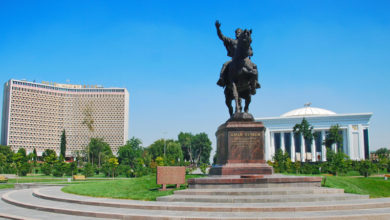Central Asia’s next transformation

The post-Soviet countries of Central Asia now have good opportunities to boost their economies and improve the living standards of their populations. This requires better use of the region’s potential and more regional integration. We are publishing the following opinion article on the issue, written by Lilia Burunciuc, regional director of the World Bank in Central Asia, and Ivailo Izvorski, World Bank lead economist for Central Asia:
It’s been almost 30 years since the five Central Asian countries have embarked on their independent paths. They have since recorded positive growth rates and made significant progress in reducing poverty. This process has gone hand in hand with their integration in the global economy.
However, despite the progress, the region has yet to reach its ample potential. Much progress can be achieved if countries prioritize reducing the state’s role in business, create conditions for a vibrant private sector, and diversify their economies.
Signs are emerging that Central Asia may finally be moving toward more robust economies and better standards of living. The beacons of hope include Uzbekistan’s dramatic reforms, improving trade-enhancing transportation infrastructure, growing economic links between Central and South Asia, and Central Asian countries’ increased willingness to tackle challenges together.
The Soviet Union’s disintegration in the early 1990s was a short-term catastrophe for Central Asia. The sudden end of production and trade links with other Soviet republics led to deep recessions. Between 1992 and 1997, per-capita income in the region fell by 50 percent to the lowest levels relative to the pre-independence levels. The private sector accounted for less than half of the region’s gross domestic product, and banks were heavily controlled, except in Kyrgyzstan.
The good news was that four of the five Central Asian countries had world-class natural resources, all had low-cost labor, and all occupied a strategic geopolitical position between Russia, China, the Middle East and South Asia. The challenge was how to use these advantages to kick-start their economies.
The four resource-rich countries have had varying degrees of success integrating with the world economy. This is a key issue because commodities account for 65 percent of Kyrgyzstan, Uzbekistan and Tajikistan’s exports and 90 percent of Kazakhstan and Turkmenistan’s. Kazakhstan has been the clear leader in global economic integration by increasing its agricultural, petroleum and minerals exports and finding ways to bypass Russia to get them to global markets. Kyrgyzstan has made progress, too, although its resources are more limited.
While Central Asian countries have made important strides toward integrating their economies with the world economy, they have not done as well integrating with each others’ economies. One reason is that their products are neither complementary nor competitive. The countries have also failed to take regional approaches to bolster their economies and address common problems. No single economic organization brings Central Asia together, as does the Association of Southeast Asian Nations (ASEAN) in East Asia.
Another mark of countries’ progress – income per capita – has been spotty in Central Asia. Per-capita income has nearly doubled in Kazakhstan, Turkmenistan and Uzbekistan since 1990. But a civil war in Tajikistan and two revolutions in Kyrgyzstan have prevented their per-capita incomes from increasing.
Central Asia also gets low grades on another element of progress – rule of law. In all five countries, weak governance is pervasive, with a damaging effect on the region’s development potential.
The outlook for the region is not all gloom and doom, however.
One sign of progress is Uzbekistan’s economic surge. In 2017 it embarked on reforms that have transformed the economy, society and governance. Price and exchange-rate controls have been loosened, and trade tariffs liberalized. Taxes on businesses and households have been cut. And the role of government – although still large – is being reduced. The changes are raising expectations of a more vibrant private sector, more opportunities for common folks, and higher incomes.
As Uzbekistan opens the door to more trade and economic integration with the world, Central Asia as a region is exploring ways to increase its exports. It is also discussing intra-regional investment opportunities and ways to boost business and entrepreneurship.
Another sign of Central Asian progress is its transportation and petroleum infrastructure-building. This goes far beyond China’s high-profile Belt and Road Initiative investments in Central Asia. Countries in the region are building roads, railroads, and pipelines that connect them with nations that can buy or transship their goods.
A recent World Bank report calculated that as a result of the BRI, exports of time-sensitive agricultural products from Central Asia are likely to increase by 8.6 percent and processed food by more than 17 percent. Infrastructure improvements from the BRI, combined with measures to reduce border crossing delays, are likely to lead to an increase in foreign direct investment by more than 7 percent, leading to increases in GDP by more than 1 percent.
Further, Central Asia’s growing links with South Asia provide opportunities for growth and exports. One example is the CASA 1000 – a transmission line that, once completed, will send surplus electricity from Kyrgyzstan and Tajikistan to Afghanistan and Pakistan. Another project, the Turkmenistan-Afghanistan-Pakistan-India pipe (TAPI) pipeline, will deliver Central Asian gas to energy-hungry South Asian countries.
The fourth sign of progress is Central Asian countries’ growing willingness to work together to solve common challenges. These include ways to strengthen regional trade, create a regional energy grid, and reduce the region’s threat of terrorism. A recent meeting of Central Asian heads of state in Tashkent captured the new spirit of cooperation.
The bottom line is that a region that many once dismissed as a victim of geography – because of its long distances, limited populations, and ethnic and cultural divisions – is on the march. Central Asian governments need to make economic and social reforms to continue the momentum.
Source: Times of Central Asia





